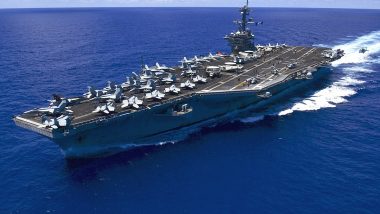Even as China’s annual session of National’s People’s Congress is underway in Beijing, the U.S. has sent a warship to Vietnam in a landmark visit.
USS Carl Vinson, a 95,000-ton nuclear powered aircraft carrier arrived at the Vietnamese port of Danang, more than four decades after the U.S. withdrew from the Vietnam War. The ship’s anchoring off Danang is symbolic as it was a key port for the U.S. during the war that ended in 1975. The docking of the vast vessel, which can support up to 90 aircrafts, will represent the largest U.S. military presence in Vietnam since the end of conflict and after the country was unified in 1975.
Publicly, the visit is being portrayed by United States government as a goodwill gesture and an act of military diplomacy as the Vinson’s crew and contingent of 5,000 sailors and aviators will visit various sites of the Vietnam War. It has been referred to as a historic opportunity to enhance the budding friendship that has emerged between the two former foes.
However, actions of such magnitude are rarely to be taken at face value in international relations and hence the warship’s arrival in Vietnamese waters seems to be a signal to China’s hegemonic intentions in the South China Sea.
South China Sea Claims
China’s claims to the South China Sea stretch roughly 1,000 miles from its southern shores, pitting it against Taiwan, the Philippines, Brunei, Malaysia, and Vietnam. The area is a key waterway through which over $5 trillion of global maritime trade passes every year. It is also rich in oil and gas which is partly the reason for China’s claim to the region.
Since 2014, China has forged ahead with island-building in the disputed waters, despite a landmark ruling in 2016 by the Permanent Court of Arbitration in The Hague, which said there was no legal basis for China's maritime claims.
Vietnam is among the claimants that have stood up most publicly against China, after the Philippines -- one of most ardent critics of Chinese expansion in the area -- reversed course under current President Rodrigo Duterte.
Arms Race In South China Sea
China’s expansionist agenda has unsettled countries in its neighbourhood. China has increased its spending on its defence budget year-on-year with an announcement on March 5 revealing this year’s budget to be an 8.1 per cent increase over previous years. Beijing will spend 1.11 trillion yuan (US$175 billion) on its military, according to a budget report presented before the opening session of the annual National People's Congress. The outlay compares with a seven percent increase last year and 7.6 per cent in 2016.
Vietnam, Japan and other countries that claim parts of the region have all expanded their defense spending in an attempt to create a barrier of what experts refer to as ‘minimal deterrence’ against China’s territorial signaling.
U.S. allies Japan and South Korea both increased their defence budgets to $43.6 and $365 billion respectively. Vietnam spends relatively less on defence than other nations in the area, it still accounts for 8% of its GDP (US$4.4 billion) and is growing. According to analytics firm IHS, nations' collective defence spending will jump from $435 billion in 2015 to around $533 billion by 2020. The region is set to account for a third of entire global military spending within the next five years.
Although the US has no direct territorial claims in the South China Sea, it plays a key role in the dispute, given its political, commercial and defence interests in the area. Washington, has vowed to continue sending military aircraft and ships near China's artificial islands in the SCS to assert navigation rights in this commercially important waterway.
Analysts say part of the U.S. strategy is to prevent China from being able to claim the waters within the so-called nine-dashed line are Chinese territorial waters. The USS Carl Vinson’s visit should hence be seen as U.S. signaling to Beijing of projecting its military as well as backing the claims of countries like Vietnam and Malaysia.
(The above story first appeared on LatestLY on Mar 06, 2018 01:00 PM IST. For more news and updates on politics, world, sports, entertainment and lifestyle, log on to our website latestly.com).













 Quickly
Quickly


